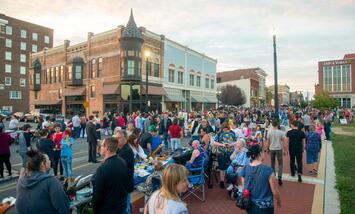
Have you ever given much thought to satellite cities? Cities located close to major metropolitan areas that aren’t the primary city, yet have a strong identity and history of their own? Cities miles away from the central city core but with many strong urbanism elements and with outstanding cost of living affordability? Satellite cities are located near many large metros, but they’re rarely considered as places that people will consider as an affordable urbanism alternative.
I first noticed satellite cities when I moved to one, Muncie, IN, while in high school. Once we moved to Muncie, I saw that there were many other similarly sized communities in central Indiana, anywhere from 30 miles to 60 miles or so away from Indianapolis – Kokomo, Anderson, Muncie, Bloomington, Lafayette – that had long histories of their own, but had relationships with the Indiana’s capital and largest city. Each of these cities started out as agricultural trading centers for surrounding farmers and then became mid-tier industrial hubs in the 20th century. Each also suffered from deep deindustrialization that set in during the 1980s. Recovery for them has been spotty; Bloomington (home of Indiana University) and Lafayette/West Lafayette (home of Purdue University) haven’t suffered the same decline as the others, thanks to the pull of flagship universities. Ball State has helped Muncie, but it hasn’t gotten the boost that Bloomington and Lafayette did.
Later, I started to notice similar relationships surrounding other large Midwestern metro areas. When our family moved to Chicago, I saw some similarly positioned cities surrounding Chicago – Waukegan, Elgin, Aurora and Joliet – in the same light. However, they were all doing somewhat better than their central Indiana cohorts. I saw the same surrounding other major Midwestern metros, all in various stages of decline or revitalization.
(Note: I find this to be almost exclusively a Midwestern phenomenon, with a few exceptions. Similar satellite cities exist in California, whose settlement owes a lot to the Midwest. California’s versions also seem to be further from the core cities. The East Coast may have once had satellite cities like the Midwest, but a case could be made that metro amalgamation began occurring there even before industrialization really took off, so the region’s cities began evolving into the more familiar Megalopolis. No similar cities appear to exist in the South.)
These are what I’ve called satellite cities. They are midsized cities that experienced a period of growth during an independent phase of development but soon found themselves being pulled toward the gravitational pull of the larger nearby metro area. Some have been fully captured by the larger metro’s pull, others haven’t fully made the transition.
Read the rest of this piece at The Corner Side Yard.
Pete Saunders is a writer and researcher whose work focuses on urbanism and public policy. Pete has been the editor/publisher of the Corner Side Yard, an urbanist blog, since 2012. Pete is also an urban affairs contributor to Forbes Magazine's online platform. Pete's writings have been published widely in traditional and internet media outlets, including the feature article in the December 2018 issue of Planning Magazine. Pete has more than twenty years' experience in planning, economic development, and community development, with stops in the public, private and non-profit sectors. He lives in Chicago.
Photo: Muncie, Indiana downtown, source: downtownmuncie.org.












